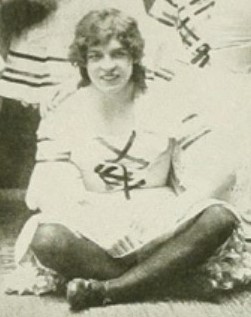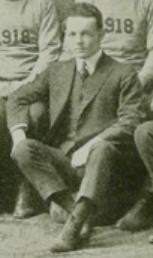JAMES C. WOOTEN, JR., 1LT, USA
James Wooten, Jr. '17
James Council Wooten, Jr. was admitted to the Naval Academy from Columbia, Tennessee on May 19, 1913 at age 19 years 4 months.
He resigned on September 4, 1914.
Lucky Bag
James is listed in the 1917 Lucky Bag under the heading "Lost at Sea."
Photographs
Loss
James was killed in action on August 1, 1918, when his airplane was shot down by German fighters near Château-Thierry, France.
Other Information
From researcher Kathy Franz:
At the Naval Academy, James won the sharpshooters medal. Per his hometown newspaper, his mother’s unhappiness when the European war began in August, 1914, caused James to secure an honorable discharge through Congressman L. P. Padgett, whose appointee he was. However, he expressed at the time the intention of re-entering the service in some capacity if America ever declared war. True to his word, he re-entered when the first American volunteers were called.
At M.I.T., James was the treasurer on the Managing Board of the M.I.T. 1916-17 Tech magazine. In 1916 and 1918, he was on the Tug-of-War Team for his Class of 1918. He was secretary of his class in his sophomore year. He was in the ballet chorus for the 17th annual Tech Show performance of “Getting A-Cross,” written by Irving Barry McDaniel, Class of 1916.
James was doing practical mining work in Globe, Arizona, in February, 1917, when the call came, and he entered the first Officers’ Training Camp at Ft. Oglethorpe. He transferred to the Coast Artillery on June 16 and graduated at Fortress Monroe in August, 1917. He sailed for France the first of September.
He was killed near Chateau Thierry, and his body was buried with full military honors in a little cemetery at Coincy, on the main road between Fere-en-Tardenois and Chateau Thierry.
In August, 1919, James’ parents visited France and toured the famous Hindenberg line. His mother worked for the Red Cross in Columbia which entitled her to work overseas in a France Red Cross canteen. At his parents’ request, James’ remains were removed to the American cemetery at Plaissy (Oise-Aisne) and placed near two other Tennessee heroes: Marines Joe B. Warren of Spring Hill and John Overton of Nashville.
In September, 1920, the James Wooten Memorial Junior Library for children was founded in his honor in Columbia.
On May 10, 1921, James’ remains were buried in the Rose Hill cemetery in Columbia. At his funeral, the local newspaper wrote: “Just as the body was being brought into the church a terrific rain and thunders rolled as though the very artillery of the mighty heaven were joining in the salute to the heroic dead.”
In 1900, he and his parents lived with his grandparents. His father and grandfather were both merchants of dry goods.
From The Herald and Mail, September 13, 1918
Describing the battle in which Lieut. Wooten was killed, Lieut. W. L. McNulty, C. A. R. C., Aero Squadron, American expeditionary forces, writing on August 6 to Mrs. Wooten said:
“As one of Jim’s best friends and a consequent sharer in your sorrow and grief, I wish to express to you and to Mr. Wooten my sincere sympathy for his loss. We had been together since first arriving in France and on entering Observation had gone to the same schools, and were members of the same Aero squadron.
“Jim was one of the most likable and best known men in our service. As an observer his work was to be envied. He was our best photographer and has also conducted very successful artillery fire. To give Jim a mission was to consider it as done. In the present advance it was vitally important to know the enemy’s intentions and so Jim was given the important task of photographing just behind the enemy’s front lines. We had breakfast together and then went on the field and prepared to take off. Jim was eager to get away and anxious to get his pictures and they soon took off. The photos were practically finished when five German planes appeared and attacked them. The men on the ground say it was the prettiest fight they had sever seen put up. But numbers told and they fell just inside our own lines. Neither he nor Lieut. Wold ever regained consciousness. They died in pursuit of their duty and heroically made the great sacrifice. Jim had performed many successful missions and I hope that consolation may be derived in the pride and joy that Jim was a good soldier and above all a man. His memory will always remain with us and I’m sure he’s now enjoying eternal peace. We all join in sending you our sorrow and sympathy.”
Per the Herald and Mail, September 20, 1918: A memorial service was held for James on Sunday, September 15, at the First Methodist church in Columbia. James became a member there when he was ten years old. A gold star was put on the church’s flag, and three speeches were heard. Mrs. W. B. Ricks wrote and read the following prose poem for him.
How loth we are to place this star of gold
Upon the one of blue, for him
Who was our friend – so true unto the end.
How proud we are to have it said of him
That every call of duty was considered done.
What comfort in the plaudit, merit won.He gave his life for us, and the value of his gift
As yet can not be told;
In God’s own time, when we can better understand,
He will unfold the mystery,
For the mysteries of both life and death
Are in His hand.We say he was so young to die,
Life is not measured by length of years,
But by what we do and how we do it,
He lives longest who lives best, and best
Who lives to love and serve, and in serving sacrifices most;
Who crowds within the months and days allotted him most loving deeds
And thoughts of others needs – forgetting self.Whence came his dauntless courage?
Was it not born of faith, faith in Him
Who marks the sparrow’s fall and guides the destinies of man?
Whence came his vision clear?
Was it not born of trust in Him,
That perfect trust that casteth out all fear?
Whence came his willing, loving service?
Was it not born of God’s own love
And love of fellow men?This life of faith and trust and love
Lives on what e’er betide
For faith and trust and love forever shall abide,
And though his body moulder neath fair France’s sod,
His soul lives on, and on, and on – with God.
From "Technology's War Record" (Massachusetts Institute of Technology):
James Council Wooten, 2nd, D.S.C.
First Lieutenant, United States Coast Artillery CorpsBorn in Columbia, Tennessee, August 7, 1896.
Prepared at the Columbia Military Academy and studied at the United States Naval Academy at Annapolis, from which he resigned in 1914.
Entered the Institute in 1914 and attended until 1917. Studied in the Course in Mining Engineering.
Member of the Beta Theta Pi fraternity, treasurer of The Tech. Member of Technique Electoral Committee, ballet of the Tech Show, Freshman and Sophomore Tug-of-War Teams and Wrestling Team.
He was graduated from the first officers' training camp at Fortress Monroe in August, 1917, and sailed for France September 6. He volunteered as an Aerial Observer. He became a member of the first All-American Squadron and performed many photographic missions, winning the Croix de Guerre and Distinguished Service Cross and being recommended for the Legion of Honor. He shot down one enemy machine and was himself twice shot down. On August 1, 1918, near Château-Thierry he encountered a formation of six German planes and together with his pilot, Lieutenant Wold, was brought down after a hard-fought battle.
(Note: there is no other evidence that he was awarded the Distinguished Service Cross.)
The Register of Alumni lists him only as a non-graduate with no other information.
James is buried in Tennessee; he was survived by his parents.
Wartime Service
From The Chattanooga News on July 8, 1918:
GERMAN PLANE FALLS IN FLAMES
Another Burst of Air Activity on American Sector of Marne Front.
COLUMBIA BOY SCORES ONE
Lieut. James Wooten Assists in Bringing Down Boche Machine.
(By Bert Ford. I. N. S. Staff Correspondent.)With the American Army at the Marne. July 7, (4 p. m.). There has been another great burst of air activity on the American sector of the Marne front during which one German machine was shot down In flames, another was compelled to land out of control while two other boche machines were forced down by American airmen attached to an observation division.
Ten American pursuit planes sighted two German tandem airplanes well within the German lines.
One of the enemy machines was sent down in flames, thanks to the teamwork of Lieut. James A. Meisner, of Brooklyn, and Lieut. Hamilton Coolidge, of Boston.
Five German monoplanes joined the fight, but were driven off after a series of thrilling air duels at an altitude of 5,000 feet.
Lieut. Sumner Sewall, of Bath, Maine, "got" his second opponent in a flight over Mouthiers, within the German lines. Nine American planes engaged six Germans. Lieut. Sewall, after a dramatic fight, pursued a German airman within a hundred feet of the ground. The last seen of the German machine it crashed to earth out of control.
This was Sewall's ninety-fifth flight.
Lieut. James Wooten, of Columbia, Tenn., and Lieut. Cowart, Pilot, in a biplane attached to the observation division, downed a boche.
Lieut. Stephen Noyes, an old Harvard quarterback, and Lieut. Doodals, flying in a tandem, also connected with the observation outfit, forced down another German plane.
American airmen had numerous thrilling escapes in spectacular fights high in the clouds. Among these Yankee flyers was Lieut. Waldo Heinrichs, of Granville, Ohio, (who had downed an enemy plane two days ago). Heinrichs pursued three enemy machines, exhausting nil his ammunition. Then he dodged behind a cloud bank and escaped unhurt.
From The Tennesseean (Nashville) on July 14, 1918:
LIEUT. WOOTEN, JR., GETS HUN IN FIGHT
John T. Wooten of Columbia has received a message from J. W. Shelton, manager of the Albany (Ala.) Daily, congratulating him upon the fact that his son, Lieut. James Wooten, Jr., had been successful in bringing down a boche air machine. Mr. Shelton stated that his paper had received telegraphic message from the International News Service to this effect.The United Press Service, the news service carried by the Dally Herald, had nothing of the occurrence as far as this paper could ascertain. However, the many friends of Lieutenant Wooten hope that it is true, and that he will get many more and be returned safely to his people here at home.
Lieutenant Wooten has been under fire a number of times, having the tail of his machine shot off once and another time his wireless apparatus was rendered useless by a Boche bullet, forcing him to have to return to his lines for another apparatus.
From the Knoxville Sentinel on September 16, 1918:
FRENCH CROSS GIVEN TO DYING COLUMBIAN
COLUMBIA, Sept. 16 — Lieut. James C. Wooten, II, C. A. R. C., died with the cross of the legion of honor upon his breast. This information was brought to Columbia in a letter from Richard Smith, who recently visited the first American aero squadron of which Lieut. Wooten was a member and heard the facts related by his comrades.
Other letters from a companion and the director of the Tech bureau in Paris to Mrs. Wooten told about this battle in which Lieut. Wooten was killed and spoke in the highest praise and admiration of the young hero.
The following extract from Lieut. Smith's letter tells about the bestoyal of the cross of the legion of honor upon the late Lieut. Wooten:
"Yesterday was the first I had heard Jim Wooten's death. As I returned from my long trip I ran into his old outfit and asked for him. They then told me how he met his death. He had gone over the lines when a swarm of Boches attacked him and his plane was shot up, but his pilot was able to make it back. Jim was taken at once to the hospital and the French officer rushed around to get the French general to confer the legion of honor. Woolen was unconscious by the time the general reached him, but he died with the cross of the legion of honor on his breast. He certainly died gloriously and every member of his old squadron spoke most highly of him.
Silver Star
From Hall of Valor:
By direction of the President, under the provisions of the act of Congress approved July 9, 1918 (Bul. No. 43, W.D., 1918), Second Lieutenant (Air Service) James C. Wooten, United States Army Air Service, is cited (Posthumously) by the Commanding General, American Expeditionary Forces, for gallantry in action and a silver star may be placed upon the ribbon of the Victory Medals awarded him. Second Lieutenant Wooten distinguished himself by gallantry in action while serving as an Observer with the 1st Aero Squadron, American Expeditionary Forces, in action near Chateau-Thierry, France, 15 July 1918, while on a photographic mission.
General Orders: GHQ, American Expeditionary Forces, Citation Orders No. 5 (June 3, 1919)
Service: Army Air Forces
Division: American Expeditionary Forces
Battalion: 1st Aero Squadron
Citation
From Find A Grave:
First Lieutenant C.A.R.C.-OBS. 1st Aero Squadron. Killed in action Chateau Thierry. D.S. Citation US Army for Distinguished and exceptional gallantry at Chateau Thierry, July 15, 1918, in the operation of the AEF, John J Pershing, Commander-in-Chief.
"As an expression of appreciation of his valor, I award him this citation in the Order of the Army, July 5, 1918. While accomplishing his mission without protection, he engaged in combat three enemy planes which he caused to draw away, then in a second combat against seven planes, during which one had to descend disabled, he himself had to descend inside our lines, wounded in the head." -Marchal Petain, Com in Chief, French Armies of the East
Memorial Hall Error
James is not listed with his classmates or on the killed in action panel in Memorial Hall. This omission was discovered while searching for additional information regarding another alumni.
James is one of 9 members of the Class of 1917 on Virtual Memorial Hall.

The "category" links below lead to lists of related Honorees; use them to explore further the service and sacrifice of alumni in Memorial Hall.




